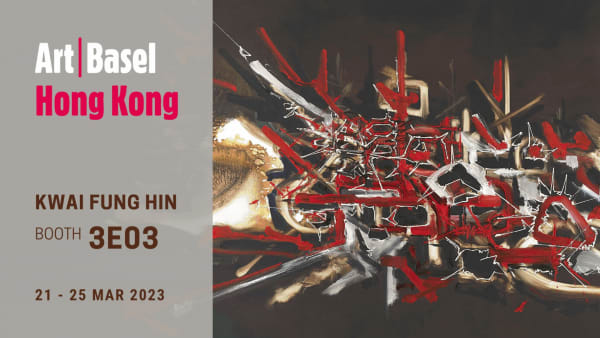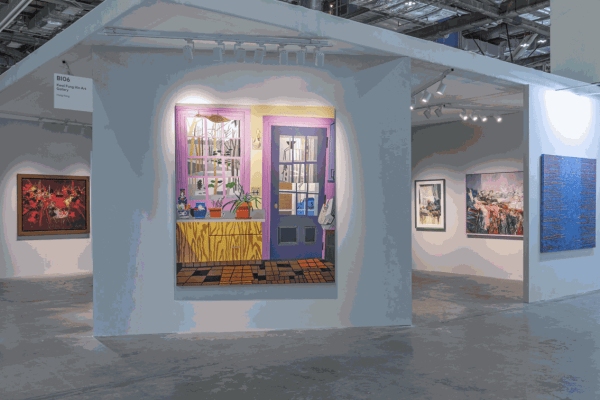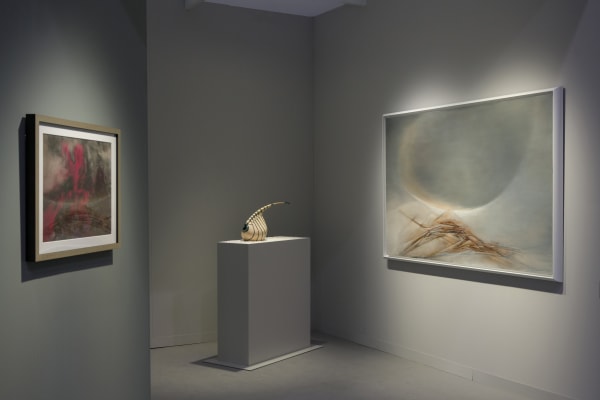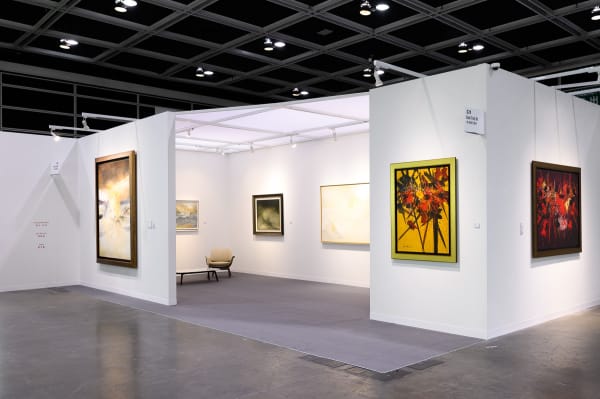Georges Mathieu 喬治 · 馬修 1921-2012
One of the fathers of Lyrical Abstraction and pioneer of action painting, the radical French painter and theorist Georges Mathieu influenced a generation of artists around the world and was declared "the strongest of new European painters" by the influential American post-war art critic Clement Greenberg. Influenced by Eastern calligraphy, and seeking a more intuitive and organic form of expression than his abstractionist predecessors, Mathieu's vision of Lyrical Abstraction was predicated upon four conditions: "a primacy of the speed of execution", the absence of any "preexistence of form" or "premeditation of gesture", as well as the importance of entering "an ecstatic state" during the creative process. His frenzied and explosive canvases were painted at a rapid pace, with spools of paint unfurling on the canvas directly from the tube. Often "performing" for audiences whilst dressed in costume, Mathieu paved the way for Performance Art and the Happenings of the 1960s, whilst his influence has also been acknowledged by the avant-garde Japanese Gutai movement.
Mathieu's artistic style underwent multiple evolutions over the course of his life:
Experiment in abstraction, early 1940s
Mathieu's experimental early years saw the development of his signature technique "Tubism", where paint was squeezed directly from the tube to the canvas.
Pioneering Lyrical Abstraction, late 1940s
Mathieu gravitated towards Lyrical Abstraction, which prioritised painterly intuition and spontaneity over the "coldness" of Geometric Abstraction.
International recognition, 1950s
Mathieu's explorations of Eastern calligraphy influenced his theories of Lyrical Abstraction, and his paintings became more overtly calligraphic in nature, with sharper brushstrokes and contrasts evoking the "wild cursive" (狂草) of traditional Chinese calligraphy - an energetic style which prized spontaneous emotional expression. Mathieu also painted his first Tachiste works (derived from the French 'tache' for blot or stain). He introduced a performative dimension to his creative process, executing huge canvases in a costumed 'calligraphic choreography' for his audiences.
Realm of the applied arts, 1960s - 1970s
At the height of his popularity in France, Mathieu sought to widen public access to his work and participated in projects involving tapestry, stamp, large sculpture, architecture and logo design.
"Cosmic shift", 1980s - 2012
This period witnessed the maturity of Mathieu's lyrical principles, with explosive "cosmic turning point" compositions executed in pure, brilliant colours.
-
 Eginhardt 《艾因哈德》, 1951
Eginhardt 《艾因哈德》, 1951 -
 Auzers《奧澤爾》, 1971
Auzers《奧澤爾》, 1971 -
 Tied Mirrors《相依鏡面》, 1986
Tied Mirrors《相依鏡面》, 1986 -
 Grande sève de feux follets《熾盛光火》, 1986
Grande sève de feux follets《熾盛光火》, 1986 -
 Vindictive Certainty 《還擊的決志》, 1987
Vindictive Certainty 《還擊的決志》, 1987 -
 Joyeux Nocturnes (Joyful Nocturnes)《愉悦的夜曲》, 1987
Joyeux Nocturnes (Joyful Nocturnes)《愉悦的夜曲》, 1987 -
 Evasion Exotique 《異國逃離》, 1987
Evasion Exotique 《異國逃離》, 1987 -
 Sérénité féconde (Fertile Serenity) 《富饒的靜謐》, 1988
Sérénité féconde (Fertile Serenity) 《富饒的靜謐》, 1988 -
 Le beau semblant (The Beautiful Semblance) 《金玉其身》, 1989
Le beau semblant (The Beautiful Semblance) 《金玉其身》, 1989 -
 Regards de flamme (Glances of Flame) 《火焰的掠影》, 1989
Regards de flamme (Glances of Flame) 《火焰的掠影》, 1989 -
 La Justice Fourvoyée (The Misdemeanor of Justice) 《正義之二端》, 1990
La Justice Fourvoyée (The Misdemeanor of Justice) 《正義之二端》, 1990 -
 Concerted Punishment《懲罰》, 1990
Concerted Punishment《懲罰》, 1990 -
 Le rien premier (The Primary Nothing)《混沌之初》, c.1980-89
Le rien premier (The Primary Nothing)《混沌之初》, c.1980-89 -
 Quête Décisive (Decisive Search) 《矢志尋索》, circa 1987
Quête Décisive (Decisive Search) 《矢志尋索》, circa 1987 -
 Exil Doux (Sweet Exile)《愜意的流放》, circa 1988
Exil Doux (Sweet Exile)《愜意的流放》, circa 1988
Early life
Georges Mathieu was born to a family of bankers on January 27, 1921, in Boulogne-sur-Mer in Northern France. He moved to Versailles at age 12 and studied Greek, Russian, and Spanish at the lycée Hoche. In 1941, he studied English literature and law at the University of Lille. A self-taught painter, he began his artistic career in 1942, making mostly landscapes and portraits, and started to explore non-figurative paintings. Apart from being an artist, he had taught English, served as interpreter for the U.S. Army and worked as professor of French at the Université Americaine, Biarritz, France.
Experiment in abstraction, early 1940s
In 1944, Mathieu started to develop the style of abstraction. He executed his first abstract drip technique painting two years before Jackson Pollock introduced his first drip painting in 1947. He quickly came to favour Tubism, the technique of applying paint to the canvas directly from the tube that Mathieu invented.
Pioneering Lyrical Abstraction, late 1940s
In 1947, mathieu moved to paris, where he worked as director of public relations in the american company united states lines but continued his pictorial exploration. In the same year, mathieu initiated a newfound aesthetic termed "lyrical abstraction" to oppose the cold geometric abstraction . It highlighted the artists' intuition, spontaneity and explosiveness, which liberated art from all the traditions. He organised exhibitions to promote lyrical abstraction, such as exhibition l'imaginaire (the imaginary) at galerie du luxembourg in 1947. he also worked closely with art michel tapié to curate exhibitions, such as h.w.p.s.m.t.b. At galerie allendy, paris (1948), white and black at galerie des deux îles (1948), and véhémences confrontées at galerie nina dausset, paris (1951), which visually pitted european lyrical critic abstraction artists against american abstract expressionists, marking mathieu's important role between the european and the american art scenes.
International recognition, 1950s
Since the very beginning of the 1950s, Mathieu started to explore Eastern calligraphy, which was an important source of inspiration for his theories and creation of Lyrical Abstraction. In 1950, Mathieu had his first solo exhibition at Galerie René Drouin in Paris, where André Malraux, Minister of Culture in France and novelist, exclaimed, "Finally, a western calligrapher!" From 1952 Mathieu began to exhibit internationally. In the 1950s, he travelled and painted in Japan, USA, Brazil, Argentina and the Middle-East. Mathieu started to introduce a performative dimension to his paintings, executing large canvases before audiences while dressed in costume. It anticipated the Performance Art and Happenings of the 1960s. The manifesto of the Japanese Gutai movement in 1956 acknowledged their “high regard” for the techniques of Mathieu's work.
Realm of the applied arts, 1960s - 1970s
In the 1960s and 1970s Mathieu received overwhelming recognition in France. Mathieu became aware of the artist's major duties towards society and expanded his creation into applied arts, including tapestries created with the Manufacture Nationale des Gobelins, 10-franc coins issued by the French government, the official logo of a new TV channel Antenna 2, and a series of posters created with the airline company Air France.
"Cosmic shift", 1980s - 2012
In the 1980s, Mathieu reached maturity of his lyrical principles. From 1985 onwards, his paintings became more explosive and emotional, with the "cosmic turning point" which eliminated the central composition and filled the entire canvas with intensive power and fields of brilliant colour.
Georges Mathieu passed away on June 10, 2012 in Boulogne-Billancourt, France at the age of 91.
Solo exhibitions
Georges Mathieu was the subject of over 170 solo exhibitions. He was honoured with major retrospective exhibitions at Musée d'Art Moderne de la Ville de Paris (1963), the Grand Palais (1978), and the Galerie Nationale du Jeu de Paume in Paris (2002).
Collections
His works are collected by more than 80 important museums around the world, including the Museum of Modern Art, New York; the Solomon R. Guggenheim Museum, New York; The Art Institute of Chicago; the Hirshhorn Museum and Sculpture Garden, Washington, DC; the Centre Pompidou, Paris; Musée National d'Art Moderne, Paris; Kunstmuseum Basel, Basel; the Tate, London and Museum of Contemporary Art, Tokyo.
-

From Landscape to Landscapes
Alliance Française de Singapour 6 - 27 Sep 2024Kwai Fung Hin is pleased to announce its debut exhibition in Singapore, From Landscape to Landscapes, a group exhibition that brings together works by artists...Read more -

The Trio - Gérard Schneider, Georges Mathieu, Pierre Soulages
Shops 01-G03 to G05, G/F, Headquarters Block, Tai Kwun, 10 Hollywood Road, Central, Hong Kong 23 Oct - 23 Dec 2021Read more -

The Cornerstone
An Exhibition Celebrating the 30th Anniversary of Kwai Fung 14 Jun - 31 Aug 2021Read more -

Calligraphy Rhapsody - Retrospective Exhibition of Georges Mathieu
Curated by Ms Catherine Kwai; Organised by K11 Foundation 19 May - 4 Jul 2021Read more -

Signifiants de l’informel 2020
11/F, Asia One Tower, 8 Fung Yip Street, Chai Wan, Hong Kong 16 Oct - 15 Dec 2020Read more -

Rue du Moulin Vert
Kwai Fung Hin Art Gallery, G/F, 20 Ice House Street, Central, Hong Kong 9 May - 16 Jun 2018An exhibition of a collection of the finest works of ZAO Wou-ki, Lalan, Pierre SOULAGES, Nicolas DE STAËL, Sam FRANCIS, Georges MATHIEU, as an associated project of Le French May 2018Read more
-

Booth 3E03 丨 ART BASEL HONG KONG 2023
21 - 25 Mar 2023Kwai Fung Hin is delighted to participate in the 2023 edition of Art Basel Hong Kong with a selection of important works by modern and contemporary artists.Read more -

Booth BI06 丨 Art SG 2023
11 - 15 Jan 2023Kwai Fung Hin Art Gallery's presentation at ART SG unites eight preeminent artists, Ziad Dalloul, Piero Dorazio, Li Huayi, Lalan, Georges Mathieu, Nicolas Party, Xue Song and Jonas Wood.Read more -

Booth 1B26丨Art Basel Hong Kong 2022
25 - 29 May 2022Read more -

Booth C2 & S24 | Fine Art Asia 2020 & Hong Kong Spotlight by Art Basel
27 - 30 Nov 2020Kwai Fung Hin Art Gallery is delighted to announce our participation in both Fine Art Asia 2020 and Hong Kong Spotlight by Art Basel.Read more
















